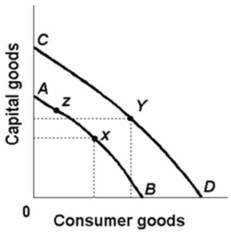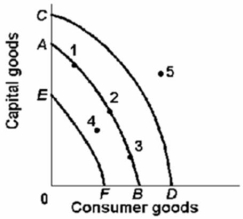A) reduce the inflation rate.
B) increase education and training.
C) slow the growth of the standard of living.
D) make industry more competitive in world markets.
F) All of the above
Correct Answer

verified
Correct Answer
verified
Multiple Choice
Over a year, a nation's GDP at current prices rose by 15 percent while the price index increased from 100 to 110.GDP at constant prices rose by about:
A) 3 percent.
B) 5 percent.
C) 7 percent.
D) 9 percent.
F) C) and D)
Correct Answer

verified
Correct Answer
verified
Multiple Choice
Real GDP was $9,950 billion in Year 1 and $10,270 billion in Year 2.What was the approximate rate of economic growth from Year 1 to Year 2?
A) 1.6 percent
B) 2.4 percent
C) 3.2 percent
D) 4.3 percent
F) C) and D)
Correct Answer

verified
Correct Answer
verified
Multiple Choice
Real GDP was $4,719 billion in Year 1 and $4,848 billion in Year 2.In contrast, real GDP per capita in Year 1 was $19,261, but in Year 2 it was only $19,162.Why did one measure increase while the other measure decreased?
A) Real GDP indicates the level of industrial production and provides a measure of the economic strength of the nation; it is the only valid measure of economic growth.
B) Inflation occurred during this period; therefore the two measures are not comparable.
C) Population increased during this time period so real GDP per capita data reflect this change.
D) Real GDP per capita measures changes in labour productivity that are not captured by a simple measure like real GDP.
F) A) and C)
Correct Answer

verified
Correct Answer
verified
Multiple Choice
Assume that an economy has 1500 workers, each working 2000 hours per year.If the average real output per worker-hour is $20, then total output or real GDP will be:
A) $3 million.
B) $30 million.
C) $45 million.
D) $60 million.
F) B) and C)
Correct Answer

verified
Correct Answer
verified
Multiple Choice
Suppose the nominal GDP of an economy was $100 billion in 2016 and $260 billion in 2017.The general price index was 100 in 2016 and 180 in 2017.During 2016-2017, the economy's real GDP rose by:
A) 160 percent.
B) 44 percent.
C) 37 percent.
D) 12 percent.
F) A) and D)
Correct Answer

verified
Correct Answer
verified
Multiple Choice
Economic growth can best be portrayed as a:
A) leftward shift of the production possibilities curve.
B) movement from a point inside to a point outside of the production possibilities curve.
C) movement from a point near the vertical axis to a point near the horizontal axis on the production possibilities curve.
D) rightward shift of the production possibilities curve.
F) None of the above
Correct Answer

verified
Correct Answer
verified
Multiple Choice
If an economy's real GDP doubles in fourteen years, then the average annual rate of growth in real GDP is about:
A) 3 percent.
B) 4 percent.
C) 5 percent.
D) 6 percent.
F) C) and D)
Correct Answer

verified
Correct Answer
verified
Multiple Choice
 Refer to the above diagram.The most likely cause of a shift from AB to CD would be a(n) :
Refer to the above diagram.The most likely cause of a shift from AB to CD would be a(n) :
A) increase in productivity.
B) increase in the price level.
C) decrease in the size of the labour force.
D) recession.
F) B) and C)
Correct Answer

verified
Correct Answer
verified
True/False
A rightward shift of a nation's production possibilities curve is a necessary but not sufficient condition for economic growth.
B) False
Correct Answer

verified
Correct Answer
verified
Multiple Choice
In Canada, the highest increase in the average annual rates of productivity growth was observed during the period of:
A) 1946-1973.
B) 1946-2015.
C) 1973-1981.
D) 2000-2015.
F) A) and C)
Correct Answer

verified
Correct Answer
verified
Multiple Choice
Refer to the diagram below.A shift in the production possibilities curve from AB to CD is most likely due to: 
A) the use of the economy's resources in an efficient way.
B) an increase in the spending of business and consumers.
C) an increase in government purchase of the economy's output.
D) an increase in the quantity and quality of labour resources.
F) A) and B)
Correct Answer

verified
Correct Answer
verified
True/False
Productivity growth is a minor source of improvements in real wage rates and the standard of living.
B) False
Correct Answer

verified
Correct Answer
verified
Multiple Choice
The historical reallocation of labour from agriculture to manufacturing in Canada has:
A) been inflationary.
B) had no effect upon the average productivity of labour.
C) increased the average productivity of labour.
D) reduced the average productivity of labour.
F) B) and C)
Correct Answer

verified
Correct Answer
verified
Multiple Choice
 Refer to the above table.Between years 1 and 2, real GDP grew by _______ percent in Italy:
Refer to the above table.Between years 1 and 2, real GDP grew by _______ percent in Italy:
A) 3
B) 4
C) 5
D) 10
F) C) and D)
Correct Answer

verified
Correct Answer
verified
Multiple Choice
During the last decade, the innovations in computers and telecommunications, together with global competition, have resulted in:
A) rational expectations theory.
B) lower growth in capital stock.
C) higher growth in labour force.
D) higher productivity growth.
F) B) and D)
Correct Answer

verified
Correct Answer
verified
Multiple Choice
The achievement of full employment through time will:
A) diminish labour productivity.
B) reduce the level of investment as a percentage of GDP.
C) increase the rate of growth of real GDP.
D) have no impact on the rate of growth of real GDP.
F) A) and B)
Correct Answer

verified
Correct Answer
verified
Multiple Choice
Which of the following is an effect of economic growth on the burden of scarcity?
A) A decrease in the burden
B) An increase in the burden
C) No effect on the burden
D) None of the answer choices are correct.
F) A) and C)
Correct Answer

verified
Correct Answer
verified
Multiple Choice
The rate of economic growth is best defined as the:
A) increase in investment as a percentage of GDP over time.
B) percentage increase in nominal GDP over time.
C) percentage increase in real GDP over time.
D) percentage increase in the quantity and quality of capital, human, and natural resources which occurs over time.
F) A) and D)
Correct Answer

verified
Correct Answer
verified
Multiple Choice
Economic growth is best defined as an increase in:
A) either real GDP or real GDP per capita.
B) nominal GDP.
C) total consumption expenditures.
D) wealth in the economy.
F) A) and C)
Correct Answer

verified
Correct Answer
verified
Showing 41 - 60 of 122
Related Exams